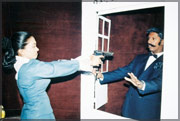|
Drama review: Well-knit and convincing family dramaDRAMA: George Bernard Shaw once said nothing satisfactory could be derived from this life. Ibsen plays provided some relief. Most probably oblivious of what the Buddha said about the unsatisfactoriness (anicca) of life, Shaw depicted how life is reflected in Western thought.
Henrik Ibsen brought on stage unsatisfactoriness of life as understood in Europe. Thus Hedda Gabler spiritually captures the taste and imagination of the Sri Lankan theatregoer. The social background against which Hedda Gabler is set, and the content delineating love, hatred and desire is not different from what we notice in the Sri Lankan upper-middle class society. Hence its message both in content and spirit, could easily reach the Sri Lankan theatregoer by piercing the thin and parochial layers of communication. It brings out the inner conflict that torments Dulsie due to the spiritual incompatibility and failure to communicate feelings which carry the heavy emotions simmering within her soul. ImaginationNamel Weeramuni’s ‘Ginnai Adarayai’, an adaptation of the original Henrik Ibsen play, enlivens the audience. It makes the theory of alienation redundant. The stage production seems to be only an extension of our experience. The Namel-Malini Punchi Theatre with its convivial and compact theatre structure agreeably designed, naturally establishes a dramatic intimacy with the audience leaving a lasting joy in their imagination. Hedda Gabler is the finest production I have viewed at this lovely, homely Punchi Theatre. Material possessions of the husband formed the initial inspiration for Dulsie (Hedda) to get married to him. His intellectual distinction played a secondary role to the main string of material wealth. However, his intellectual disposition proved to be a diversion and an impediment on her smooth flow in marital life. The play revolves around her romantic aspirations and evolves into a confrontation with forces offensive to her objectives. Her husband’s pre-occupation with academic interests transformed her inner sensibilities replete with desires and fears into one of tragedy. Female friendWhen Douglas reveals to her that his research work on the history of cancer is the life and soul of his close female friend, it shakes her out of her senses. By burning the book she eliminates the main obstacle, which enshrined the sentiments of love and breath of her rival who stood on the way to her husband’s promotion to professorial eminence. Thus while she defended the official and academic figure of her husband, she destroyed the heart and soul that robbed her of the spirit of love that had sprung within her. For Dulsie, books symbolised the honeymoon she spent with her husband, but it only satisfied the inner claims of her husband, which depended on reading and writing. Each character of the play, with the exception of Martin, is subtle and volatile. The solid structure of the play demands a high standard of thespian performance to which the artists responded well with a commitment. In this production except Malini Weeramuni, every other artist is a novice yet they performed admirably well to sustain the tempo of the play and hold the audience attention. The setting of the stage displaying the sitting room of Dulsie’s new middle-class home is both fascinating and illuminating. It was ideally arranged to enhance the effect of performance of the artists. Its contribution in appearance and composition, complement each other. The audience feels no separation of the performance on stage from the spectator below. It was so cleverly enacted. The costumes are plain and simple but neatly and delicately designed to match the social status of each character. MomentumThe play unfolds on a sober introductory note which soon gathers pace and momentum to advance with undulating rhythm maintained with powerful and well balanced presentation and goes on up-to the very end. Dulsie’s obsession with burning hatred towards the research work of Douglas is conveyed effectively to the audience with figurative portrayal of the sound of folk drum music enriched by devil dancing, reverberating into the atmosphere with the accompanying lighting effect reaching the climax. Sinhala theatre as a whole is rich with translations and adaptations of plays from the West, and Gindarai Adarayai is another worthy addition to the volume of such stage productions. It is so well-knit, convincing and bold, the spectators do not feel the play stealing their undiluted attention and absorption. The dexterity with which Hedda (Eshanthi Mendis) enlivened the dramatic situations depicting fine acting talent and intellectual maturity of a seasoned actress, deserves recognition. |
|
|
.................................. |









